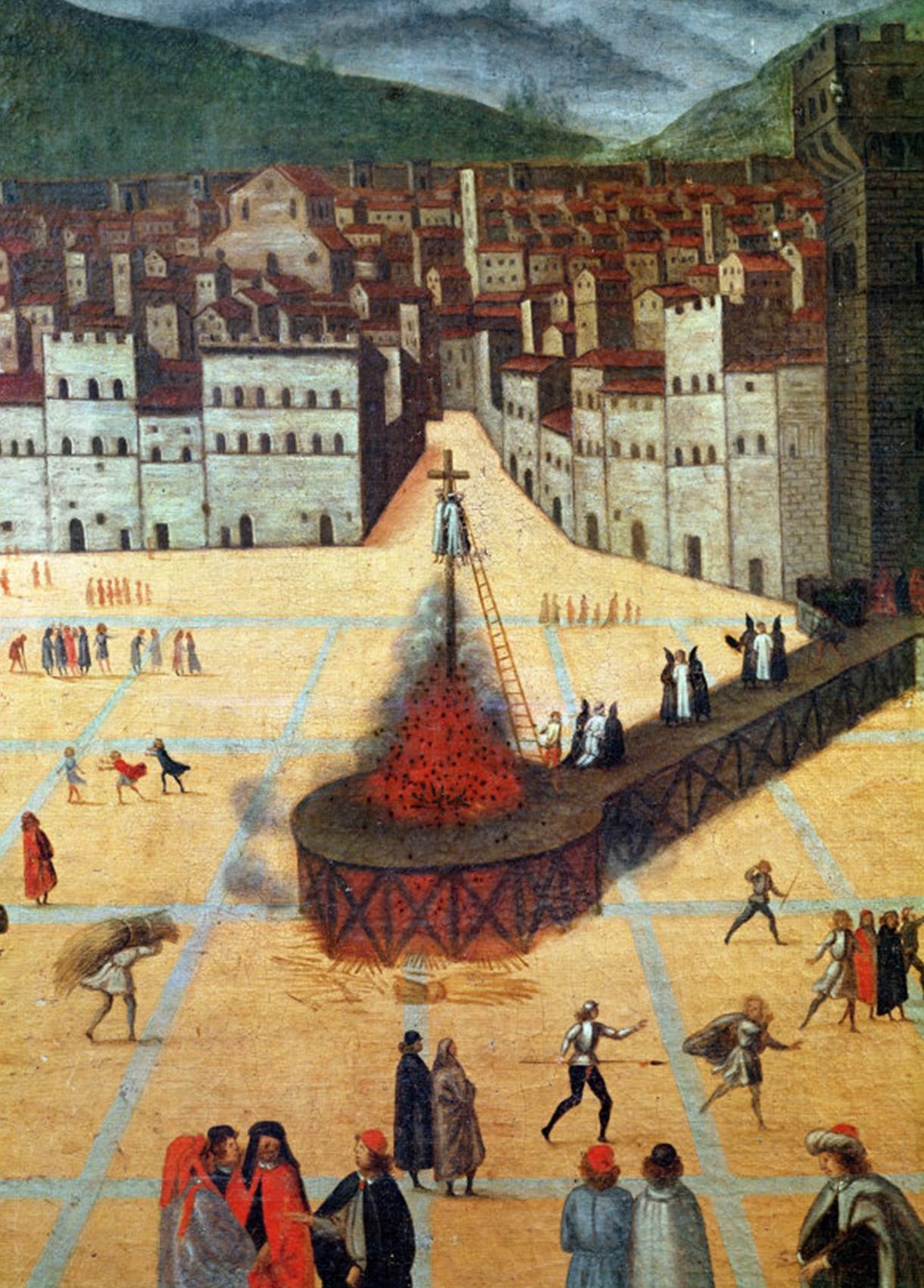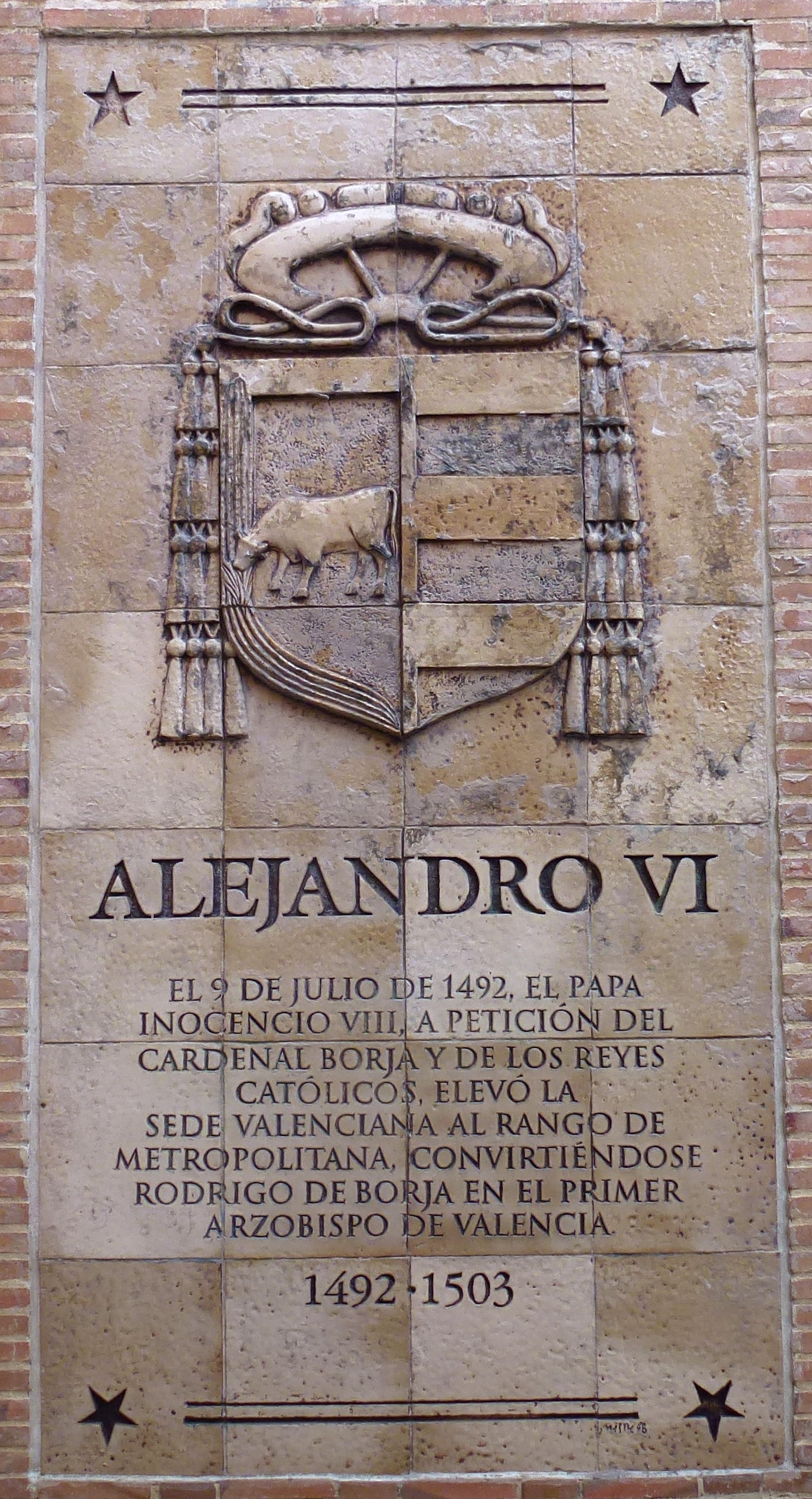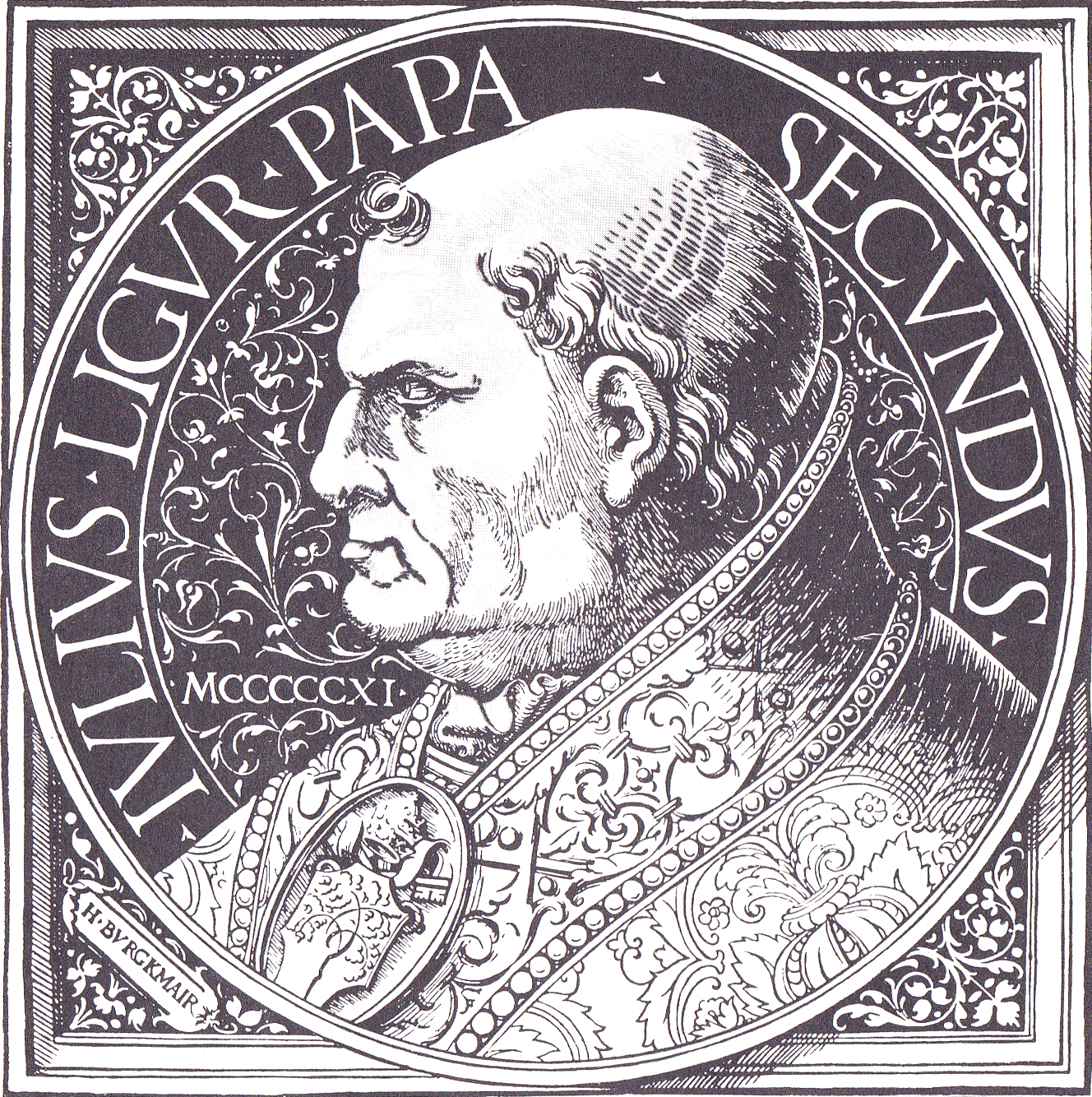|
Renaissance Papacy
The Renaissance Papacy was a period of papal history between the Western Schism and the Reformation. From the election of Pope Martin V of the Council of Constance in 1417 to the Reformation in the 16th century, Western Christianity was largely free from schism as well as significant disputed papal claimants. There were many important divisions over the direction of the religion, but these were resolved through the then-settled procedures of the papal conclave. The popes of this period were a reflection of the College of Cardinals that elected them. The College was dominated by cardinal-nephews (relatives of the popes that elevated them), crown-cardinals (representatives of the Catholic monarchies of Europe), and members of the powerful Italian families. There were two popes each from the House of Borgia, House of della Rovere, and House of Medici during this period. The wealthy popes and cardinals increasingly patronized Renaissance art and architecture, (re)building the ... [...More Info...] [...Related Items...] OR: [Wikipedia] [Google] [Baidu] |
Papal States
The Papal States ( ; ; ), officially the State of the Church, were a conglomeration of territories on the Italian peninsula under the direct sovereign rule of the pope from 756 to 1870. They were among the major states of Italy from the 8th century until the unification of Italy, which took place between 1859 and 1870, culminated in their demise. The state was legally established in the 8th century when Pepin the Short, king of the Franks, gave Pope Stephen II, as a temporal sovereign, lands formerly held by Arian Christian Lombards, adding them to lands and other real estate formerly acquired and held by the bishops of Rome as landlords from the time of Constantine onward. This donation came about as part of a process whereby the popes began to turn away from the Byzantine emperors as their foremost temporal guardians for reasons such as increased imperial taxes, disagreement with respect to iconoclasm, and failure of the emperors, or their exarchs in Italy, to pro ... [...More Info...] [...Related Items...] OR: [Wikipedia] [Google] [Baidu] |
Lorenzo II De Medici
Lorenzo di Piero de' Medici (; 12 September 1492 – 4 May 1519) was the ruler of Florence from 1516 until his death in 1519. He was also Duke of Urbino during the same period. A scion of the Medici, his wealth and power saw his daughter Catherine de' Medici become Queen Consort of France, while his recognised but illegitimate son, Alessandro de' Medici, inherited his estate and became the first Duke of Florence. Early life Lorenzo was born in Florence on 12 September 1492, a son of Piero di Lorenzo de' Medici and Alfonsina Orsini. His paternal grandparents were Lorenzo the Magnificent and Clarice Orsini. His maternal grandparents were Roberto Orsini, Count of Tagliacozzo and his wife, Catherine of San Severino. Career Lorenzo II became lord of Florence in August 1513, after his uncle, Giuliano de' Medici, handed over control of its government. Ambitious by nature, Lorenzo II, despite being appointed Captain of the Florentine militia, lacked patience with Florence's ... [...More Info...] [...Related Items...] OR: [Wikipedia] [Google] [Baidu] |
War Of Urbino
The War of Urbino (January–September 1517) was a secondary episode of the Italian Wars. The conflict ensued after the end of the War of the League of Cambrai (1508–16), when Francesco Maria I della Rovere decided to take advantage of the situation to recover the Duchy of Urbino, from which he had been ousted in the previous year by troops of the Papal States. In early 1517 he presented himself under the walls of Verona to hire the troops which had besieged the city, now to be returned to the Republic of Venice. Della Rovere set off with an army of some 5,000 infantry and 1,000 horses which he entrusted to Federico Gonzaga, lord of Bozzolo, reaching the walls of Urbino on 23 January 1517. He defeated the Papal condottiero Francesco del Monte and entered the city hailed by the population. Pope Leo X reacted by hastily hiring an army of 10,000 troops under Lorenzo II de' Medici, Renzo da Ceri, Giulio Vitelli, and Guido Rangoni and sent it against Urbino. Lorenzo was woun ... [...More Info...] [...Related Items...] OR: [Wikipedia] [Google] [Baidu] |
Pope Leo X
Pope Leo X (; born Giovanni di Lorenzo de' Medici, 11 December 14751 December 1521) was head of the Catholic Church and ruler of the Papal States from 9 March 1513 to his death in December 1521. Born into the prominent political and banking Medici family of Florence, Giovanni was the second son of Lorenzo de' Medici, ruler of the Florentine Republic, and was elevated to the cardinalate in 1489. Following the death of Pope Julius II, Giovanni was elected pope after securing the backing of the younger members of the College of Cardinals. Early on in his rule he oversaw the closing sessions of the Fifth Council of the Lateran, but struggled to implement the reforms agreed. In 1517 he led a costly war that succeeded in securing his nephew Lorenzo di Piero de' Medici as Duke of Urbino, but reduced papal finances. In Protestant circles, Leo is associated with granting indulgences for those who donated to reconstruct St. Peter's Basilica, a practice that was soon challenged by M ... [...More Info...] [...Related Items...] OR: [Wikipedia] [Google] [Baidu] |
Cesare Borgia
Cesare Borgia (13 September 1475 – 12 March 1507) was a Cardinal (Catholic Church)#Cardinal_deacons, cardinal deacon and later an Italians, Italian ''condottieri, condottiero''. He was the illegitimate son of Pope Alexander VI of the Aragonese people, Aragonese House of Borgia and was a sibling to Lucrezia Borgia. After initially entering the Church and becoming a cardinal on his father's election to the papacy, he resigned his diaconal profession after the death of his brother in 1498. He was employed as a ''condottiero'' for King Louis XII of France around 1500, and occupied both Milan and Naples during the Italian Wars. At the same time, he carved out a state for himself in Central Italy, but he was unable to retain power for long after his father's death. His quest for political power was a major inspiration for ''The Prince'' by the renowned Florence, Florentine historian, Niccolò Machiavelli. Early life Like many aspects of Cesare Borgia's life, the date of his birth i ... [...More Info...] [...Related Items...] OR: [Wikipedia] [Google] [Baidu] |
Pope Alexander VI
Pope Alexander VI (, , ; born Roderic Llançol i de Borja; epithet: ''Valentinus'' ("The Valencian"); – 18 August 1503) was head of the Catholic Church and ruler of the Papal States from 11 August 1492 until his death in 1503. Born into the prominent Borja family in Xàtiva in the Kingdom of Valencia under the Crown of Aragon, he was known as Roderic de Borja, and he is commonly referred to by the Italianized form as Rodrigo Borgia. He studied law at the University of Bologna. He was ordained deacon and made a cardinal in 1456 after the election of his uncle as Pope Callixtus III, and a year later he became vice-chancellor of the Catholic Church. He proceeded to serve in the Roman Curia under the next four popes, acquiring significant influence and wealth in the process. In 1492, Rodrigo was elected pope, taking the name Alexander VI. Alexander's papal bulls of 1493 confirmed or reconfirmed the rights of the Spanish crown in the New World following the finds of Christop ... [...More Info...] [...Related Items...] OR: [Wikipedia] [Google] [Baidu] |
War Of The League Of Cognac
The War of the League of Cognac (1526–1530) was fought between the Habsburg dominions of Charles V—primarily the Holy Roman Empire and Spain—and the League of Cognac, an alliance including the Kingdom of France, Pope Clement VII, the Republic of Venice, the Kingdom of England, the Duchy of Milan, and the Republic of Florence. Prelude Shocked by the defeat of the Kingdom of France in the Italian War of 1521, Pope Clement VII, together with the Republic of Venice, began to organize an alliance to drive Charles V from the Italian Peninsula. Francis I, having signed the Treaty of Madrid, was released from his captivity in Madrid and returned to France, where he quickly announced his intention to assist Clement. Thus, on 22 May 1526, the League of Cognac was signed in the town of Cognac, France by Francis, Clement, Venice, Florence, and the Sforza of Milan, who desired to throw off the Imperial hegemony over them. Henry VIII of England, thwarted in his requests to h ... [...More Info...] [...Related Items...] OR: [Wikipedia] [Google] [Baidu] |
Pope Clement VII
Pope Clement VII (; ; born Giulio di Giuliano de' Medici; 26 May 1478 – 25 September 1534) was head of the Catholic Church and ruler of the Papal States from 19 November 1523 to his death on 25 September 1534. Deemed "the most unfortunate of the popes", Clement VII's reign was marked by a rapid succession of political, military, and religious struggles—many long in the making—which had far-reaching consequences for Christianity and world politics. Elected in 1523 at the end of the Italian Renaissance, Clement came to the papacy with a high reputation as a statesman. He had served with distinction as chief advisor to Pope Leo X (1513–1521, his cousin), Pope Adrian VI (1522–1523), and commendably as gran maestro of Florence (1519–1523). Assuming leadership at a time of crisis, with the Protestant Reformation spreading, the Church nearing bankruptcy, and large foreign armies invading Italy, Clement initially tried to unite Christendom by making peace among the m ... [...More Info...] [...Related Items...] OR: [Wikipedia] [Google] [Baidu] |
League Of Cambrai
The League of Cambrai was a military coalition against the Republic of Venice formed on 10 December 1508, by the main European powers (Holy Roman Empire, France, Aragon and their allies), to maintain their hegemony over the Italian Peninsula. The League was formalized by two treaties, both signed on 10 December 1508 in Cambrai, first being a dynastic treaty between Habsburg and Valois rulers, and the second being a wider treaty of military alliance against the Venetians. It gave name to the War of the League of Cambrai. In 1510, the League started to dissolve, and it finally collapsed in 1511. Treaties of Cambrai In the autumn of 1508, imperial and French delegations met at Cambrai. Rulers were not present in person. The emperor was represented by his daughter, archduchess Margaret of Austria (governess of the Habsburg Netherlands), who was accompanied by Mercurino di Gattinara (president of the Burgundian parliament) and Matthäus Lang von Wellenburg (at that time bi ... [...More Info...] [...Related Items...] OR: [Wikipedia] [Google] [Baidu] |
Pope Julius II
Pope Julius II (; ; born Giuliano della Rovere; 5 December 144321 February 1513) was head of the Catholic Church and ruler of the Papal States from 1503 to his death, in February 1513. Nicknamed the Warrior Pope, the Battle Pope or the Fearsome Pope, it is often speculated that he had chosen his papal name not in honor of Pope Julius I but in emulation of Julius Caesar. One of the most powerful and influential popes, Julius II was a central figure of the High Renaissance and left a significant cultural and political legacy. As a result of his policies during the Italian Wars, the Papal States increased their power and centralization, and the office of the papacy continued to be crucial, diplomatically and politically, during the entirety of the 16th century in Italy and Europe. In 1506, Julius II established the Vatican Museums and initiated the rebuilding of the St. Peter's Basilica. The same year he organized the famous Swiss Guard for his personal protection and commanded a su ... [...More Info...] [...Related Items...] OR: [Wikipedia] [Google] [Baidu] |
Canonization
Canonization is the declaration of a deceased person as an officially recognized saint, specifically, the official act of a Christianity, Christian communion declaring a person worthy of public veneration and entering their name in the canon catalogue of saints, or authorized list of that communion's recognized saints. Catholic Church Canonization is a Pope, papal declaration that the Catholic Church, Catholic faithful may Veneration, venerate a particular deceased member of the church. Popes began making such decrees in the tenth century. Up to that point, the local bishops governed the veneration of holy men and women within their own dioceses; and there may have been, for any particular saint, no formal decree at all. In subsequent centuries, the procedures became increasingly regularized and the Popes began restricting to themselves the right to declare someone a Catholic saint. In contemporary usage, the term is understood to refer to the act by which any Christianity, Ch ... [...More Info...] [...Related Items...] OR: [Wikipedia] [Google] [Baidu] |





